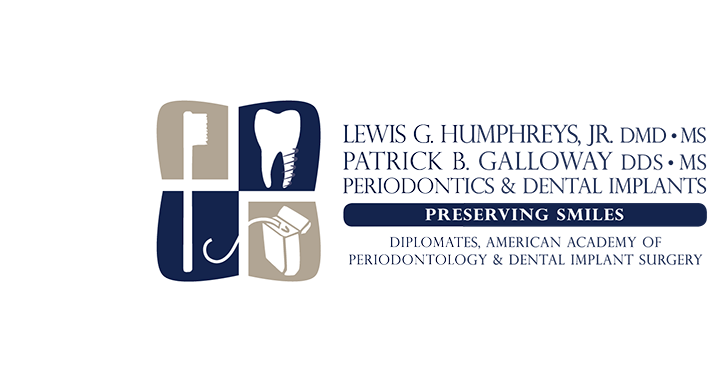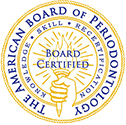Surgical Periodontal Therapy

Dental Implants
Dental implants have several component parts. The implant itself is a titanium screw that is placed in the jawbone to serve as a mechanical replacement of the tooth root. They can serve as support for single or multiple crowns, bridgework, and dentures. After a period of healing, normally three months, a second component, the abutment, is attached to the implant body. Abutments vary from "snap" attachments for dentures, to posts for crown and bridgework. A new scanning technology allows for the fabrication of "custom milled abutments” which will produce a more esthetic final restoration. Find out more under our Dental Implants heading. Dr. Humphreys and Dr. Galloway offer complimentary dental implant consultations.
All On 4 Dental Implant
Patients who have trouble wearing a conventional denture or who desire a full arch fixed prosthesis may benefit greatly from the All on 4 dental implant concept. Four precisely placed dental implants in the upper or lower jaw can serve to support a fixed restoration that replaces all of your teeth in that jaw. A screw retained dental prosthesis is attached to the implants giving the patient the security of something that does not move or fall out. In many cases, teeth can be extracted, the implants placed, and a temporary denture affixed in the same day.
Immediate Implants
An immediate dental implant is a dental implant that is placed in the jawbone immediately after a dental tooth extraction. It is usually placed at the same visit as the dental extraction but it can be done within two weeks after the dental tooth extraction and still be considered an immediate dental implant. If a crown or dental bridge is placed on an immediate dental implant to restore the tooth, this is considered immediate loading. Immediate loading of an immediate dental implant is the most favorable option for any patient.
The key advantage to an immediate dental implant:
- Fixed tooth replacement that looks as good or better than the extracted tooth
- One dental surgery and no stitches
- Helps preserve gum tissue
- Can be less painful
Bone Grafting
Bone grafting is used to restore a large amount of bone tissue that has deteriorated due to gum disease. There are several types of grafting materials; however, most encourage new bone growth.
Crown Lengthening
Crown lengthening may be recommended for prosthetic or esthetic reasons. It is also indicated when a tooth has fractured or decayed beneath the gum line. Crown lengthening is useful in providing tooth length without compromising the supporting gum tissue or the strength of the future restoration.
Frenectomy
A frenulum is a fiber attachment that connects the mucosa of your lips or tongue to surrounding gum tissue. While everyone has frenelum in their mouth, only a few will ever need treatment to have it removed.
A labial frenulum, if attached too high, can pull on the gum tissue, causing recession. It is also associated with a diastema (space between teeth) which needs to be removed during orthodontic therapy. A lingual frenulum (under the tongue) can cause speech problems and may need to be removed. A frenectomy is a minor surgical procedure that trims or removes the frenulum.
Gingivectomy and Gingivoplasty
A gingivectomy reduces excessive gum tissue, while a gingivoplasty reshapes gum tissue. Both procedures involve the removal and re-contouring of your gum tissue to improve your appearance and facilitate better health.
Guided Tissue Regeneration
Periodontal disease causes loss of bone and connective tissue. Today, through Guided Tissue Regeneration (GTR), Dr. Humphreys and Dr. Galloway can promote the regrowth of ligament fibers and bone. A bone graft may be used in conjunction with this procedure.
Gum Grafting
Gum grafting involves adding gum tissue to treat gum recession or irritation. This prevents future tooth loss due to root decay, vigorous tooth brushing, or root abrasion. Teeth that are cold, sensitive, or have obvious “lengthy root” appearances will benefit from the improved cosmetic look that gum grafting provides.
Lasers
In dentistry, lasers are used for a variety of procedures, including dental surgery, filling cavities, and whitening teeth. In periodontics, lasers can be used to treat deep pockets, promote soft tissue healing, and perform many periodontal plastic surgical procedures.
Pocket Elimination Surgery
Pocket elimination treatment is the surgical removal of deep periodontal pockets. This procedure allows for effective removal of plaque and calculus deposits. Eliminating unnecessary pocket depth increases the possibility that your home care will be effective in controlling disease.
Ridge Augmentation
Ridge augmentation is a procedure performed to repair defects due to extraction or tooth loss. This procedure enables teeth to be replaced (by your referring dentist) with optimum functional and esthetic results. Ridge Augmentation will almost always involve some type of grafting – bone or gum – and, sometimes, both types of grafts.





